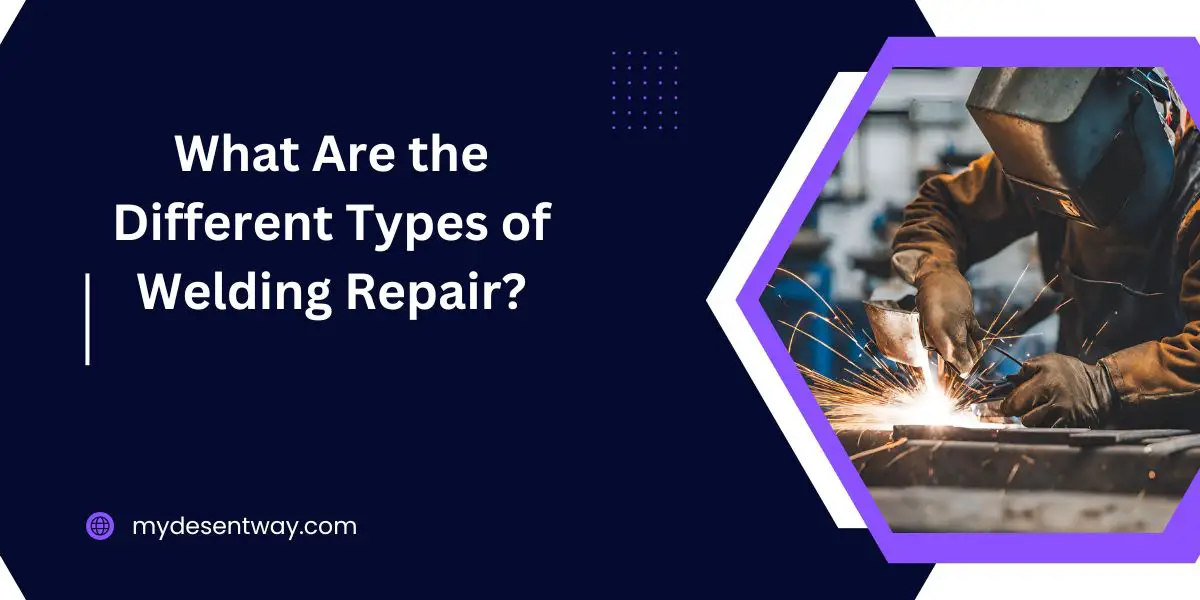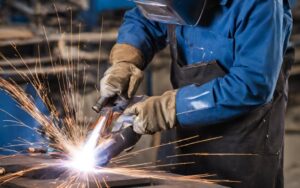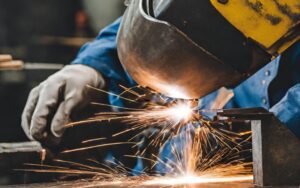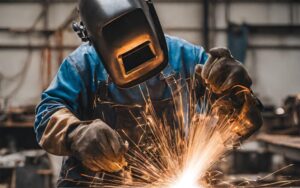Table of Contents
- Recognizing the Need for Repairing Welds
- What Are the Different Types of Welding Repair?
- Arc Welding
- Metal Inert Gas (MIG) Welding or Gas Metal Arc Welding (GMAW)
- Laser Beam Welding
- Oxy-Fuel Welding and Cutting
- Electroslag Welding
- Flux-Cored Arc Welding (FCAW)
- FAQS about what are the different types of welding repair?
The in-depth article on the different types of welding repair will encompass various techniques and their applications, catering to both beginners and seasoned professionals.
Recognizing the Need for Repairing Welds
The necessity for welding repair arises from the inevitable wear and tear experienced by metal structures over time. Whether due to environmental factors, operational stress, or unforeseen accidents, metal components often face degradation or damage that requires remediation.
Importance of Expertise in Welding Repair
Effective welding repair isn’t merely about joining metals together; it’s about restoring the strength, durability, and functionality of the damaged component. Skilled welders and technicians play a crucial role in identifying the extent of damage, selecting the appropriate repair technique, and executing it with precision.
Range of Applications
Welding repair finds application across diverse sectors, ranging from automotive and aerospace industries to construction and infrastructure development.
Whether it’s fixing a small crack in a steel beam or conducting extensive repairs on heavy machinery, the versatility of welding repair techniques ensures their relevance across various domains.
Embracing Technological Advancements
Advancements in technology have revolutionized welding repair methodologies. From traditional arc welding techniques to state-of-the-art laser welding, evolution has brought forth more precise, efficient, and specialized methods tailored to different repair needs.
Future of Welding Repair
The future of welding repair continues to evolve, driven by innovations aimed at enhancing precision, efficiency, and sustainability.
With a growing emphasis on automation, robotics, and advanced materials, the landscape of welding repair is poised for further advancements, promising more effective and environmentally friendly solutions.
What Are the Different Types of Welding Repair?
Exploring the spectrum of welding repair techniques reveals a myriad of approaches, each unique in its application and advantages.
Gas Tungsten Arc Welding (GTAW)
Gas Tungsten Arc Welding (GTAW), commonly known as TIG welding, is a precise and versatile welding method widely used across various industries. This technique utilizes a non-consumable tungsten electrode to create the weld, while an inert gas, typically argon, shields the weld area from atmospheric contamination.
Understanding GTAW
GTAW is renowned for its ability to produce high-quality, clean welds with minimal spatter. Its precision makes it a preferred choice in applications demanding meticulous welds, such as aerospace, automotive, and high-end fabrication.
Applications and Uses
The versatility of GTAW allows it to be applied to a wide range of materials, including stainless steel, aluminum, copper, and alloys. Its clean welds without spatter make it particularly suitable for applications where aesthetics and structural integrity are paramount, like artwork, aerospace components, and critical joints in machinery.
Advantages and Limitations
The notable advantages of GTAW include its ability to produce high-quality welds, excellent control over the heat input, and the absence of flux or filler material, resulting in clean, precise welds.
However, its relatively slower welding speed and the requirement for skilled operators are considered limitations, making it less productive for high-volume production.
Evolving Innovations in GTAW
The advancement of GTAW technology continues with the introduction of automated systems and specialized equipment. Robotic GTAW setups are increasingly utilized in industries requiring repetitive, high-precision welding tasks, enhancing productivity while maintaining quality standards.
Arc Welding
Arc welding stands as one of the oldest and most versatile welding methods, relying on the creation of an electric arc between an electrode and the workpiece to generate the heat required for fusion.
Overview of Arc Welding
Arc welding encompasses a spectrum of techniques, each utilizing different types of electrodes, power supplies, and shielding methods. Shielded Metal Arc Welding (SMAW), commonly known as stick welding, and Gas Metal Arc Welding (GMAW/MIG) are prominent examples of arc welding techniques.
Types and Techniques
-
Shielded Metal Arc Welding (SMAW)
A disposable electrode coated in flux is used in SMAW. As the electrode melts, the flux creates a shielding gas, protecting the weld pool from atmospheric contamination. SMAW is versatile and can be used in various positions, making it widely used in construction, maintenance, and repair.
-
Gas Metal Arc Welding (GMAW/MIG)
GMAW uses a continuous wire electrode fed through a welding gun, along with a shielding gas, typically a mix of argon and carbon dioxide. This method offers higher productivity and is suitable for both thin and thick materials, making it prevalent in the automotive, fabrication, and manufacturing industries.
Pros and Cons
Arc welding techniques boast several advantages, including versatility in welding different metals, ease of operation, and the ability to work in various positions.
However, factors such as spatter, fumes, and the need for a clean working surface can be considered drawbacks, requiring proper safety precautions and workspace preparation.
Innovations in Arc Welding
Advancements in arc welding technology focus on improving efficiency, precision, and safety. Automation and robotics are increasingly integrated into arc welding processes, enhancing productivity and consistency while reducing human error.
Electric Resistance Welding (ERW)
Electric Resistance Welding (ERW) stands as a prevalent welding technique that utilizes electrical resistance to generate heat for welding metal components together.
Explanation of ERW
In ERW, an electrical current passes through the metal components to be welded, generating heat due to the resistance encountered by the materials. This heat results in the desired fusion, creating a strong and reliable bond between the metals.
Applications and Examples
ERW finds extensive use in various industries, notably in the manufacturing of pipes, tubing, and cylindrical components. Its ability to create seamless welds makes it a preferred method for producing high-quality pipes used in the plumbing, construction, and oil and gas industries.
Strengths and Weaknesses
The strengths of ERW lie in its ability to create welds quickly and efficiently, especially in continuous welding processes. It produces welds with excellent strength and uniformity. However, ERW may have limitations when welding thicker materials or when dealing with materials prone to corrosion, requiring proper surface preparation and post-weld treatments.
Technological Advancements in ERW
Technological advancements in ERW have focused on enhancing efficiency, precision, and the ability to handle diverse materials. Improved monitoring systems, better control over heat input, and advancements in welding equipment have contributed to more consistent and reliable welds.
Metal Inert Gas (MIG) Welding or Gas Metal Arc Welding (GMAW)
Metal Inert Gas (MIG) Welding, also known as Gas Metal Arc Welding (GMAW), is a widely used welding process that employs a continuous wire electrode and a shielding gas to create strong and durable welds.
Defining MIG/GMAW
MIG/GMAW involves feeding a consumable wire electrode through a welding gun while simultaneously feeding a shielding gas, typically a mix of argon and carbon dioxide, to protect the weld pool from atmospheric contamination. This method is known for its versatility, ease of use, and ability to produce high-quality welds.
Industrial and Domestic Applications
MIG/GMAW finds extensive applications across various industries, from automotive and construction to shipbuilding and manufacturing. Its versatility allows for welding various metals, including steel, aluminum, and stainless steel, making it a popular choice for both industrial and DIY welding projects.
Benefits and Drawbacks
One of the significant advantages of MIG/GMAW is its high welding speed, allowing for efficient completion of projects. Additionally, it produces clean welds with minimal splatter, reducing post-weld cleanup.
However, the equipment setup and initial cost can be higher compared to some other welding methods. Moreover, outdoor welding can be challenging due to the susceptibility of the shielding gas to wind interference.
Technological Advancements in MIG/GMAW
Technological advancements in MIG/GMAW have focused on enhancing productivity, weld quality, and ease of operation. Innovations in equipment design, wire compositions, and gas mixtures aim to improve penetration, reduce spatter, and widen the range of materials that can be effectively welded using this method.
Laser Beam Welding
Laser Beam Welding stands as a highly precise and efficient welding method that utilizes a concentrated laser beam to join metals together.
Insights into Laser Welding
Laser welding involves focusing a high-powered laser beam onto the surfaces of the materials to be joined, creating a narrow and intense heat source. This concentrated heat generates a weld by melting and fusing the metals together, resulting in a remarkably small heat-affected zone and minimal distortion.
Industries Using Laser Welding
Laser welding finds extensive applications in industries requiring high precision and where stringent quality standards are crucial. Sectors such as electronics, aerospace, automotive, and medical device manufacturing benefit significantly from the precision and cleanliness of laser welds.
Pros and Cons
The advantages of laser welding include its ability to create precise and aesthetically appealing welds on thin and delicate materials, as well as its high welding speed and minimal need for post-weld cleanup. However, the initial setup costs and the need for specialized training for operators might be considered as drawbacks.
Technological Advancements in Laser Welding
Advancements in laser welding technology aim to enhance its capabilities further. Improvements in beam delivery systems, control mechanisms, and the integration of robotics have increased efficiency and expanded the range of applications for laser welding.
Additionally, advancements in fiber and diode lasers have made the technology more accessible and cost-effective.
Oxy-Fuel Welding and Cutting
Oxy-Fuel Welding and Cutting, an age-old method, utilizes the combustion of oxygen and a fuel gas to generate the heat required for welding and cutting metal.
Understanding Oxy-Fuel Welding
In oxy-fuel welding, a torch mixes oxygen with a fuel gas, commonly acetylene, producing a flame that reaches temperatures sufficient to melt and fuse metals. This method enables the welding of various metals, including mild steel, cast iron, and copper alloys.
Practical Uses and Advantages
Oxy-Fuel welding finds applications in metal fabrication, repair work, and artistic endeavors. Its portability and versatility make it useful for fieldwork and situations where electricity isn’t readily available. Additionally, it allows for welding thicker materials compared to some other methods.
Disadvantages and Safety Concerns
While versatile, oxy-fuel welding has certain limitations. The process generates considerable heat, leading to distortions and a larger heat-affected zone compared to some modern welding methods.
Safety concerns revolve around the handling of flammable gases, the risk of explosions, and the production of harmful fumes, necessitating proper ventilation and safety measures.
Technological Innovations
Advancements in oxy-fuel welding focus on improving safety measures, enhancing equipment efficiency, and reducing environmental impact. Newer torch designs and gas mixtures aim to increase precision and control while minimizing heat-affected zones and fumes.
Electroslag Welding
Electroslag Welding (ESW) stands as a specialized welding process primarily used for welding thick materials in a single pass, making it highly efficient for specific industrial applications.
Overview of Electroslag Welding
Electroslag Welding operates by creating an arc between the electrode and the workpiece, which initiates the melting process. As the slag covering the weld pool melts due to the heat generated by the arc, it forms a conductive medium, enabling a high current to pass through the molten slag and the workpiece.
This sustained electrical resistance generates intense heat, leading to the fusion of the metal, creating a strong and continuous weld.
Specific Applications
ESW finds particular utility in welding thick sections of materials, especially in applications requiring a deep penetration weld in a single pass.
Industries such as shipbuilding, nuclear power plants, and heavy machinery manufacturing utilize this method for welding large components like thick plates, beams, and sections where conventional welding techniques might be less efficient.
Strengths and Weaknesses
One of the significant advantages of ESW is its ability to weld thick materials quickly and efficiently, reducing the need for multiple passes. It produces high-quality, high-strength welds with excellent mechanical properties. However, its setup requires specific conditions, such as a controlled environment to manage the molten slag effectively. Additionally, the initial setup costs and limitations in welding thinner materials are noteworthy considerations.
Technological Advancements in ESW
Advancements in Electroslag Welding focus on refining the process to accommodate a broader range of materials and thicknesses.
Improvements in power sources, flux formulations, and electrode designs aim to enhance efficiency, reduce heat-affected zones, and expand the applicability of ESW in different industrial sectors.
Flux-Cored Arc Welding (FCAW)
Flux-Cored Arc Welding (FCAW) is a versatile welding process that utilizes a continuous tubular electrode filled with flux to join metals, offering high welding speeds and suitability for various applications.
Definition of FCAW
FCAW is an arc welding process that combines elements of both MIG welding and SMAW. The electrode used in FCAW is tubular and contains a flux material that shields the weld pool from atmospheric contamination, reducing the need for external shielding gases.
Industry Applications
FCAW finds extensive applications across industries requiring fast and efficient welding on thick materials. Its adaptability to various base metals, including carbon steel, stainless steel, and alloys, makes it suitable for construction, shipbuilding, pipelines, and heavy fabrication.
Advantages and Disadvantages
One of the primary advantages of FCAW is its high welding speeds, making it ideal for high-production environments. Additionally, it excels in welding thick materials and can operate well in outdoor conditions.
However, the flux material can lead to slag residue that requires post-weld cleanup, and the process may be less suitable for thinner materials due to the potential for excessive penetration.
Innovations in FCAW
Technological advancements in Flux-Cored Arc Welding focus on improving electrode compositions, enhancing flux formulations, and developing equipment that allows for better control and consistency. These innovations aim to reduce spatter, increase weld quality, and widen the range of applications for FCAW.
FAQS about what are the different types of welding repair?
Which welding method is best for precision welding?
Gas Tungsten Arc Welding (GTAW) is renowned for its precision due to its clean and spatter-free welds.
Which welding method is faster for thick materials?
Flux-Cored Arc Welding (FCAW) offers high welding speeds and is suitable for welding thick materials.
Are all welding methods suitable for DIY projects?
No, some methods, like Electroslag Welding are more industrial and may not be practical for DIY use.
Which welding method is faster for thick materials?
Flux-coated arc welding (FCAW) offers high welding speeds and is suitable for welding thick materials.
Is Laser Beam welding suitable for small-scale applications?
Yes, Laser Beam Welding offers exceptional precision and is ideal for welding small, intricate components




11 thoughts on “What Are the Different Types of Welding Repair?”